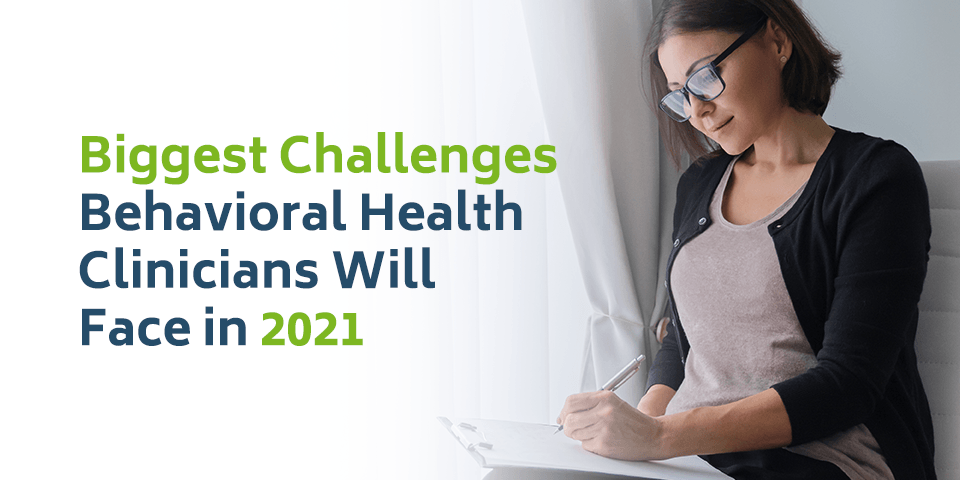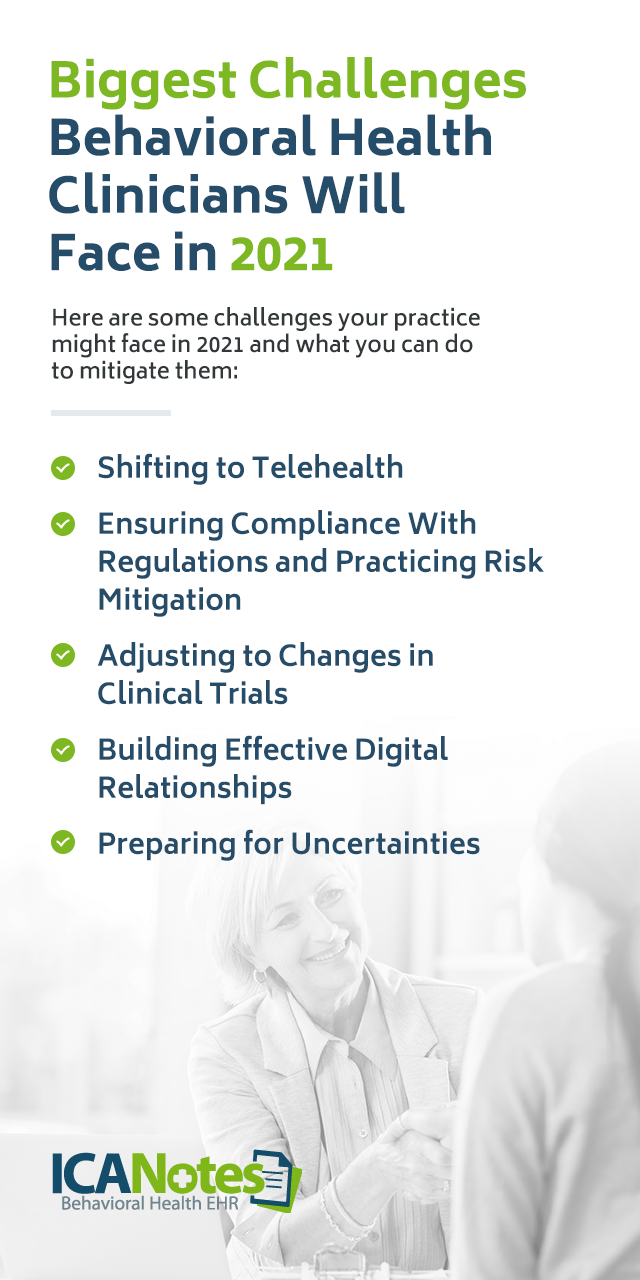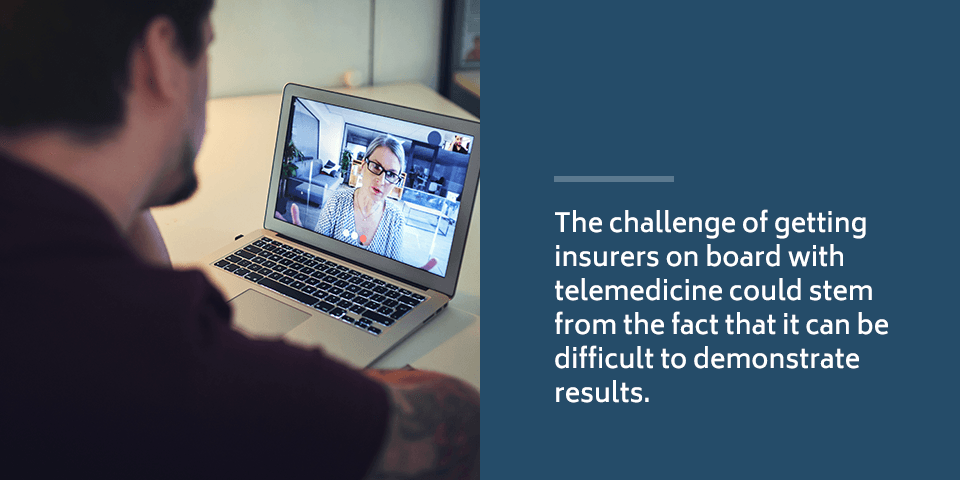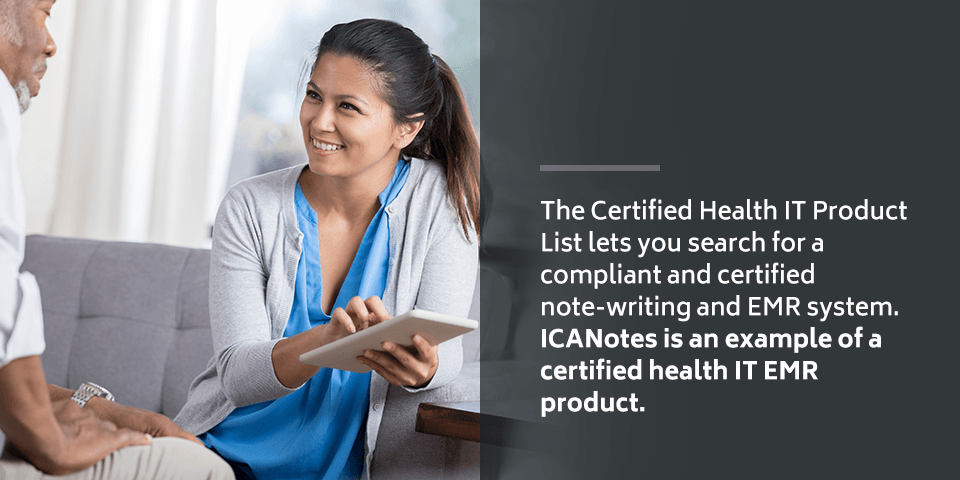Biggest Challenges Behavioral Health Clinicians Will Face in 2022
Whether you're a psychiatrist, clinical social worker, psychologist or counselor, a career in behavioral health can be challenging but rewarding. You need to have excellent communication skills and high levels of compassion to succeed in the behavioral health field. Beyond providing high-quality patient care, behavioral health clinicians need to navigate challenges in mental health services, such as changing regulations and an increasing shift to telemedicine.
Table of Contents
- Shifting to Telehealth
- Ensuring Compliance With Regulations and Practicing Risk Mitigation
- Adjusting to Changes in Clinical Trials
- Building Effective Digital Relationships
- Preparing for Uncertainties
Recognizing the current issues in mental healthcare allows you to make a plan for addressing them to continue offering the best care possible to your clients. Here are some challenges your practice might face in 2021 and what you can do to mitigate them:
1. Shifting to Telehealth
The COVID-19 pandemic dramatically changed the way people receive health care. While there is a legitimate concern that many people put off or canceled treatments they needed, the pandemic also accelerated the shift to telehealth or telemedicine. Telehealth allows clinicians to provide care to their clients remotely.
Usually, the patient and provider connect over video conferencing software, allowing the clinician to provide synchronous care. Another option is asynchronous care, meaning the provider communicates with their client using voice or text messages. A client can message their counselor, psychologist or psychiatrist and the clinician can respond later.
As with any major change, shifting to telehealth has benefits for clients and providers — along with some challenges to address when adopting the practice.
Benefits of Telehealth
Of all the healthcare specialties, behavioral health might be best suited for telemedicine. Since it focuses on a patient's mental and emotional well-being more than physical issues, clinicians don't need to perform physical exams when interacting with clients.
One notable benefit of increasing telemedicine in behavioral health is expanding access to therapy, psychiatric services and other behavioral health practices. Using telehealth, a clinician can offer patients therapy individually or in a group setting. Clinicians can perform psychiatric evaluations and help patients manage their medications. A doctor can also educate patients using telehealth.
Expanding telehealth usage means people who live in areas that previously weren't well-served by behavioral health can now schedule visits with clinicians without leaving their homes. Remote visits also often work better with a client's schedule than in-person appointments. Since patients remain at home for the visit, they don't have to arrange transportation to the provider's office or leave time for a commute in their schedule. Often, scheduling telehealth visits increases patient compliance and reduces the number of no-shows.
Behavioral health telemedicine can also help reduce the stigma associated with getting treatment for mental or emotional health concerns. Since the client remains at home, they don't have to explain to co-workers or friends where they are going. They can feel more at ease opening up to their care provider, especially when in a familiar and safe space like their own home.
Many telehealth options exist, including videoconferencing and phone calls. A phone call might be preferable for clients who aren't comfortable using videoconferencing technology or who might not have a reliable internet connection at home.
Challenges of Telehealth
While telehealth does have many benefits and people have been quick to embrace it, the method isn't without its challenges. One issue can be getting insurance companies on board with it. Many insurance businesses supported the shift to telemedicine amid the COVID-19 pandemic. Still, it remains unclear whether they will continue to support and provide coverage for telehealth in the future once the pandemic ends.
The challenge of getting insurers on board with telemedicine could stem from the fact that it can be difficult to demonstrate results. Clinicians need to develop ways to show patients' progress, such as a drop in substance use for those dealing with substance use disorders or an improvement in depression for people with major depression. Having patients fill out questionnaires virtually that they would usually complete in-office is one way to demonstrate the effectiveness and measure the quality of care.
Another obstacle is getting clients to use the system. Although the switch to remote sessions and videoconferencing was novel and embraced by many at the start of the pandemic, compliance eventually dropped off and no-shows increased. The schedule upheavals many people felt due to the pandemic could also contribute to difficulties in remembering when an appointment is scheduled or what day it is. Reminders sent over text, through a phone call or via email the day before a telehealth visit can increase compliance and reduce no-shows.
2. Ensuring Compliance With Regulations and Practicing Risk Mitigation
Two major changes are taking place in 2021 that behavioral health providers need to be aware of. One change affects the Current Procedure Terminology (CPT) codes a practice uses to describe the services or treatments a prescribing clinician provided. For 2021, the Centers for Medicare and Medicaid Services (CMS) has changed the process of entering and using the evaluation and management (E/M) codes. Becoming aware of those changes and what they mean allows your practice to remain compliant with coding.
In 2016, Congress passed the 21st Century Cures Act (CURES). One notable part of the Act goes into effect in April 2021. The rule will require clinicians to give patients electronic access to their health information, free of charge. The new rule is part of the section of CURES that deals with information blocking or info blocking.
What Is Information Blocking?
Info blocking denies access to electronic health information to a doctor, health care provider or the patient themselves. The CURES Act outlines specific examples of information blocking actions. They include:
- Using health information technology (IT) in a non-standard way, making it difficult for someone to access or use electronic health information (EHI).
- Using practices that limit authorized access or use of health information.
- Using health IT to prevent EHI from completely traveling between health information technology systems or contribute to health IT fraud.
A crucial component of information blocking is knowledge. If the actor — i.e., a behavioral health clinician or practice — uses IT in a way they know will restrict access to the EHI, they are participating in info blocking.
Information blocking can take several forms, including restricting access, restricting exchange and limiting EHI use. A clear way to understand the terms is as follows:
- Access: Access refers to making EHI available for use or exchange.
- Exchange: Exchange refers to transmitting EHI between systems, platforms, networks and technologies. For example, allowing one provider's electronic medical record (EMR) system to share information with another practice's EMR platform.
- Use: Use is how the EHI is acted upon or understood.
There are some notable exceptions to the information blocking rule in the CURES act. For example, you don't have to comply with the rule if providing access to the EHI will cause harm or if the access will violate a patient's privacy.
How to Comply With Information Blocking
Starting April 5, 2021, clinicians will need to provide patients with electronic access to their EHI, including clinical notes. Whatever system you currently use for clinical records needs to also provide online access to your clients and must be HIPAA compliant.
Using a certified health IT EMR system is the easiest way to ensure your practice complies with the new ruling. The Certified Health IT Product List lets you search for a compliant and certified note-writing and EMR system. ICANotes is an example of a certified health IT EMR product.
You can remain compliant without using a certified system, but doing so will require you to verify that the platform is configured correctly. Using a non-certified system that blocks information sharing can result in federal fines.
In December 2020, ICANotes held a webinar that discussed the new ruling and highlighted the changes that go into effect in April 2021, as well as the exceptions. You can register to view a recording of the webinar to learn more about how the new ruling can affect your practice and how you can remain in compliance.
3. Adjusting to Changes in Clinical Trials
The pandemic also affected how clinical trials are carried out. As people needed to stay home unless absolutely necessary during the earliest phases of the pandemic, many professionals managing clinical trials had to find ways to continue studies with limited in-person contact. The shift brought benefits and challenges.
As with telehealth, one benefit of remote or reduced in-person clinical trials was that people no longer had to travel to get the care or medicine being studied. The reduced need for travel can make certain trials more attractive to patients who might benefit from them the most, as the barrier of accessing transportation is eliminated.
A challenge that exists when implementing remote trials is figuring out how to put them into practice. There need to be effective ways to ensure patients get access to the medications that might be part of the trial. They also need to be able to self-administer the medications or treatments and need to know exactly how to report changes or side effects they experience.
Technology, including videoconferencing and EMR systems, can help smooth the transition to decentralized trials, provided all participants and providers are on board with using the technology.
4. Building Effective Digital Relationships
Often, healthcare technology focuses on streamlining and simplifying processes for the patient, neglecting the needs of clinicians who also need to use the technology. Behavioral health clinicians must deal with inefficient administrative tasks and complex regulatory requirements when using EMR systems. Getting paid and digitally tracking claims tend to be long and drawn-out processes.
Improving the relationship clinicians have with their digital tools offers several benefits to these providers and the patients they serve. When clinicians spend less time figuring out administrative details or entering data into an EMR, they have more time to spend with their clients.
Improving the digital tools a clinician uses can also improve the quality of care they provide their clients. A physician who isn't worrying about whether they input data properly or who doesn't have to spend hours hunting down a claim can better focus on developing a treatment plan for a client. Higher quality care tends to lead to better outcomes for patients, which is a win for all.
In many ways, changes to the relationship that providers have with their EMR systems and other digital tools have been spurred by the pandemic. CMS relaxed some requirements during the pandemic, reducing the burden on providers. For example, CMS eased restrictions on providing telehealth services across state lines, allowing people who had to relocate due to the pandemic to continue working with their clinicians.
The shift from in-office work to remote or telehealth work that the pandemic spurred also likely affected clinicians' mental health. Many doctors themselves could likely benefit from teletherapy or telepsychiatry during the pandemic, throughout 2021 and beyond. Providing support and therapy to clinicians can help reduce the risk of burnout and improve their client relationships.
5. Preparing for Uncertainties
Better days and a post-pandemic world are likely ahead. What remains unclear is when those days will begin. Some clients might continue to delay the care and therapy they need because of concerns about another wave of the pandemic potentially rising.
It's up to clinicians to provide clients with information about public safety and office procedures to make them feel prepared for a return to in-office care. Clinicians can also continue to offer telehealth visits as an option for those who may not be ready or able to travel to the physical practice for visits.
Another issue behavioral health clinicians will likely face in 2021 is evaluating the present demand for their services. Major shifts, such as a pandemic, can lead to a drop in appointments followed by a sharp increase in demand. Predicting such events will most likely require a partnership between providers, local agencies and local governments to get an accurate look at what will happen next.
Request a Free Trial of ICANotes
As technology becomes more and more a part of providing high-quality care to your clients, your practice needs a certified EMR that will help you remain compliant and streamline the note-writing process for clinicians. ICANotes is a certified electronic medical IT product with preconfigured templates for all settings and disciplines. With this platform, you can create comprehensive progress notes, treatment plans, assessments and more.
You can also benefit from unlimited one-on-one training sessions from our support team, receiving priority access to our friendly and knowledgeable experts over phone, email or live chat. To learn more about ICANotes and see it in action, schedule a free trial today.
Related Posts
What to Know About the New E/M Coding Changes for 2021
Why You Should Share Behavioral Health Notes With Patients
How to Make Your Practice Virtual
Self-Care for Behavioral Health Professionals
Sources
- https://www.bls.gov/ooh/community-and-social-service/substance-abuse-behavioral-disorder-and-mental-health-counselors.htm#tab-4
- https://www.bls.gov/ooh/healthcare/physicians-and-surgeons.htm#tab-4
- https://www.psychiatry.org/patients-families/what-is-telepsychiatry
- https://www.cdc.gov/coronavirus/2019-ncov/hcp/telehealth.html
- https://www.medpagetoday.com/meetingcoverage/phc/89034
- https://www.psychiatry.org/psychiatrists/practice/practice-management/coding-reimbursement-medicare-and-medicaid/coding-and-reimbursement
- https://chpl.healthit.gov/#/search
- https://www.bigmarker.com/icanotes/Open-Notes-Mandate-What-is-All-of-the-Fuss-About-12-30-2020
- https://www.healthit.gov/topic/information-blocking
- https://www.ama-assn.org/system/files/2021-01/information-blocking-part-1.pdf
- https://www.healthleadersmedia.com/innovation/information-blocking-what-know-and-how-navigate-next-steps
- https://www.healthit.gov/curesrule/resources/information-blocking-faqs
- https://www.pwc.com/us/tophealthissues





